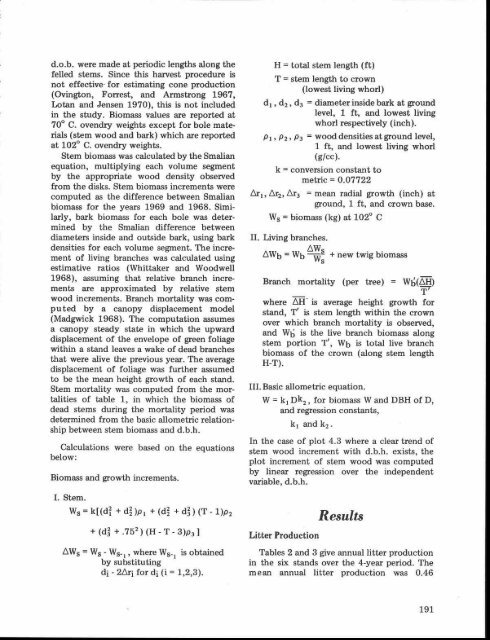PE EIE[R-Rg RESEARCH ON - HJ Andrews Experimental Forest
PE EIE[R-Rg RESEARCH ON - HJ Andrews Experimental Forest
PE EIE[R-Rg RESEARCH ON - HJ Andrews Experimental Forest
Create successful ePaper yourself
Turn your PDF publications into a flip-book with our unique Google optimized e-Paper software.
d.o .b. were made at periodic lengths along th e<br />
felled stems. Since this harvest procedure i s<br />
not effective- for estimating cone productio n<br />
(Ovington, Forrest, and Armstrong 1967 ,<br />
Lotan and Jensen 1970), this is not include d<br />
in the study . Biomass values are reported at<br />
700 C. ovendry weights except for bole materials<br />
(stem wood and bark) which are reporte d<br />
at 102° C. ovendry weights .<br />
Stem biomass was calculated by the Smalian<br />
equation, multiplying each volume segment<br />
by the appropriate wood density observed<br />
from the disks . Stem biomass increments wer e<br />
computed as the difference between Smalian<br />
biomass for the years 1969 and 1968 . Similarly,<br />
bark biomass for each bole was deter -<br />
mined by the Smalian difference betwee n<br />
diameters inside and outside bark, using bark<br />
densities for each volume segment . The increment<br />
of living branches was calculated using<br />
estimative ratios (Whittaker and Woodwel l<br />
1968), assuming that relative branch increments<br />
are approximated by relative ste m<br />
wood increments . Branch mortality was computed<br />
by a canopy displacement model<br />
(Madgwick 1968). The computation assume s<br />
a canopy steady state in which the upward<br />
displacement of the envelope of green foliag e<br />
within a stand leaves a wake of dead branche s<br />
that were alive the previous year . The average<br />
displacement of foliage was further assume d<br />
to be the mean height growth of each stand .<br />
Stem mortality was computed from the mortalities<br />
of table 1, in which the biomass o f<br />
dead stems during the mortality period wa s<br />
determined from the basic allometric relation -<br />
ship between stem biomass and d .b.h .<br />
Calculations were based on the equation s<br />
below :<br />
Biomass and growth increments .<br />
H = total stem length (ft )<br />
T = stem length to crown<br />
(lowest living whorl )<br />
d i , d2 , d 3<br />
= diameter inside bark at ground<br />
level, 1 ft, and lowest living<br />
whorl respectively (inch) .<br />
P 1, P2, P3 = wood densities at ground level ,<br />
1 ft, and lowest living whorl<br />
(g/cc) .<br />
k = conversion constant t o<br />
metric = 0 .0772 2<br />
Ar' 1 , Ore, Ara = mean radial growth (inch) at<br />
ground, 1 ft, and crown base.<br />
Ws = biomass (kg) at 102° C<br />
II. Living branches.<br />
AWb = Wb ~ s<br />
Ws<br />
+ new twig biomass<br />
Branch mortality (per tree) = Wb(AH )<br />
T '<br />
where AH . is average height growth for<br />
stand, T' is stem length within the crown<br />
over which branch mortality is observed ,<br />
and Wb is the live branch biomass along<br />
stem portion T' , Wb is total live branc h<br />
biomass of the crown (along stem lengt h<br />
H-T) .<br />
III. Basic allometric equation .<br />
W = k 1 D k 2 , for biomass W and DBH of D ,<br />
and regression constants ,<br />
k 1 and k 2 .<br />
In the case of plot 4 .3 where a clear trend of<br />
stem wood increment with d .b.h . exists, the<br />
plot increment of stem wood was computed<br />
by linear regression over the independent<br />
variable, d .b.h .<br />
I. Stem .<br />
Ws = k[(di + di )P1 + (di + 43) (T - 1)p2<br />
+(d3 + .75 2 ) (H-T-3)ps ]<br />
AWs = W s - Ws- 1 , where Ws- 1 is obtaine d<br />
by substituting<br />
di - 2Ori for di (i = 1,2,3) .<br />
Litter Productio n<br />
Results<br />
Tables 2 and 3 give annual litter productio n<br />
in the six stands over the 4-year period . The<br />
mean annual litter production was 0 .4 6<br />
191








